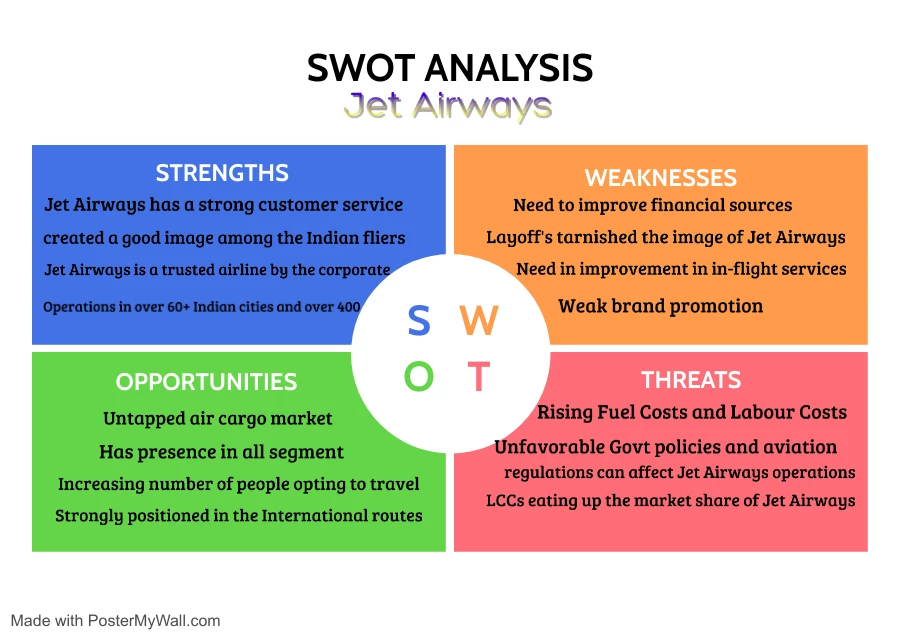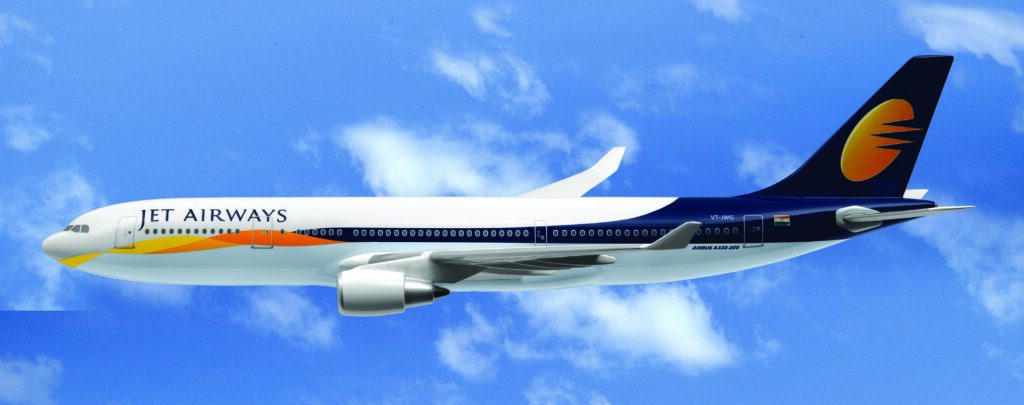Jet Airways (India) Ltd is a Mumbai-based international airline. It was once India’s largest airline. From its main hub at Chhatrapati Shivaji International Airport and secondary hubs at Chennai International Airport, Indira Gandhi International Airport, Kempegowda International Airport, and Netaji Subhas Chandra Bose International Airport, it operated over 300 flights per day to 74 destinations worldwide.
To better understand the reasons for the company’s continuous growth, let’s look into the SWOT Analysis of Jet Airways, which is required for any company to survive and thrive in the market.
A SWOT analysis is used to assess a company’s strengths, weaknesses, opportunities, and threats. Its primary goal is to assist organizations in gaining a thorough understanding of all the factors that influence business decisions.
So, in this case study, we’ll learn about Jet Airways and the SWOT Analysis of Jet Airways. So, Let’s get started.
About Jet Airways
Jet Airways Ltd. is an Indian airline headquartered in Mumbai. It was established as a private company on April 1, 1992. It was founded by Naresh Goyal, a London-based businessman. On May 5, 1993, they began operations as an Air Taxi Operator with a fleet of four leased Boeing 737 aircraft.
On January 14, 1995, they were granted scheduled airline status and later on it became a recognized public company on July 1, 1996. It was then reorganized as a private company on January 19, 2001, and on the 28th of December, 2004, it became a public company.
Jet Airways was India’s first private airline to operate to foreign destinations. In India’s domestic market, it has a reasonably large market share (about 20%)
Now that we’ve covered the company’s fundamentals, let’s look at Jet Airways’ S.W.O.T analysis in the section below.
SWOT Analysis of Jet Airways
A SWOT analysis is a method of determining a company’s strengths, weaknesses, opportunities, and threats.
It’s a great tool for figuring out where the company excels and where it falls short, devising countermeasures, and figuring out how the company can grow. So let’s analyze Jet Airways’ SWOT analysis in the section below.

SWOT Analysis of Jet Airways | IIDE
1. Strengths of Jet Airways
The distinct capabilities of an organization that gives it a competitive advantage in capturing more market share, attracting more customers, and maximizing profits are referred to as its strengths.
- Vertically Integrated Operations: Jet Airways provides passenger and cargo services as well as aircraft leasing. The company operates in various parts of the world and has vertically integrated all operations, allowing it to serve a diverse range of customers and thus gain a competitive advantage.
- Strong network portfolio: Jet Airways has a strong fleet base as well as a strong network. The company operates 116 aircraft with 20 international and 48 domestic destinations in India. This assists the company in increasing operational margins.
- Focus on IT and E-Commerce Innovation: Jet Airways combined its services with travel packages to provide customers with an all-inclusive experience. It has also launched a smartphone airline application to assist users. Such initiatives assist the company in improving operational performance.
- Alliance with Etihad Airways: Jet Airways has formed a strategic alliance with Etihad Airways in order to expand into new markets. The collaboration broadened the airline’s international reach.
2. Weaknesses of Jet Airways

Weaknesses are aspects of a company or brand that need to be improved. So, let’s take a look at Jet Airways’ major weaknesses:
- Limited market share: Jet Airways competes with a variety of commercial and public airlines both locally and internationally, resulting in a market share that is limited and difficult to develop.
- Negative margins are a source of concern: Despite increased revenues, Jet Airways saw negative growth in FY 2015. Year over year, the operating margin was down (-6.2%) and the net margin was down (-9.6%). Negative margins have an impact on the company’s future ambitions.
- Customer Dissatisfaction: Many customers have complained about flight delays at various airports over the years. Many people have also expressed their dissatisfaction with the airline’s poor response time to customer concerns.
- Dependency: This over-dependence on the Indian market may have a dampening influence on the company’s revenues if the economy and/or the company’s sales in India do not grow as expected. Its high reliance on the domestic market may limit its ability to contribute to the local economy’s growth. It makes the corporation more vulnerable to changes in the country’s economic and political condition.
3. Opportunities for Jet Airways
Opportunities are areas in which a firm might focus in order to improve outcomes, sales, and, eventually, profit. So, let’s see what kind of opportunities Jet Airways can pursue in order to achieve excellent results.
- Wide-reaching strategic alliances: In order to develop further over the world, Jet Airways should consider forming alliances with other international airlines, such as collaborating with Etihad Airways.
- Positive growth in the Indian aviation industry: In recent years, the Indian airline industry has experienced rapid and exponential expansion. The industry has grown its operations and increased the number of flights on practically all routes. The industry is likely to continue to grow at a similar rate, which is good for Jet Airways.
- Growing Tourism Industry: According to the World Tourism Organization (UNWTO), foreign tourist arrivals climbed by roughly 4.4 per cent in 2015. The expansion will help the company, which now operates in over 20 worldwide countries.
4. Threats of Jet Airways
Environmental variables that can inhibit a company’s growth are known as threats. Some of Jet Airways’ threats are as follows:
- Regulations drive up compliance costs: In the aviation business, a corporation must comply with a slew of legislative, transportation, and environmental regulations, all of which drive up compliance costs and, as a result, impairs operating margins.
- High Gasoline Prices: One of the concerns that the corporation has faced in recent years is the rise in fuel prices. As a result, they have had to raise ticket prices and have lost consumers to their competitor airlines. They are facing issues not just in the domestic market, but also in the international market due to international competitors.
- Intense rivalry in the aviation industry: Intense competition exists in both the domestic and international aviation industries, resulting in price competitiveness. As pricing pressures increase, operating margins are impacted, and the industry suffers as a result.
Let’s wrap up the case study in the section below now that we’ve thoroughly examined Jet Airways’ SWOT Analysis.
Conclusion
As time passes, Jet Airways evolves in every possible domain of the aircraft industry, provided that the challenges and threats grow in accordance with the market opportunities. As a result, it must change its operational priorities in order to meet the expectations of both the high and low end of the demanding population.
The market division, thus dividing the aircraft industry into parts based on the mode of operation, has forced airliners like Jet Airways to do something renowned and distinct to stand out from the crowd.
The company’s SWOT analysis aided in the formulation of key recommendations, such as establishing a new vision and strategy and adhering to current performance indicators.
Please let us know what you think about this case study in the comments section below. Thank you for reading this, and if you enjoyed it, please share it with your friends and family.
Read more such insightful case studies on IIDE’s case studies page.







0 Comments